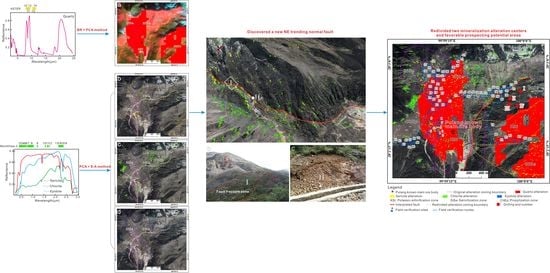New Insights into the Pulang Porphyry Copper Deposit in Southwest China: Indication of Alteration Minerals Detected Using ASTER and WorldView-3 Data
Abstract
:1. Introduction
2. Materials and Methods
2.1. Geological Setting
2.2. Remote Sensing Data and Characteristics
2.3. Pre-Processing of Remote Sensing Data
2.4. Hydrothermal Alteration Mineral Mapping Methods
2.4.1. Combination of the Band Ratio and Principal Component Analysis Methods
Band Ratio
Principal Component Analysis
2.4.2. Principal Component Analysis and Spectrum-Area Methods
3. Results
3.1. Quartz Alteration Mineral Extraction Using a Combination of the Band Ration and Principal Component Analysis Methods along with ASTER Data
3.2. Hydrothermal Alteration Minerals Extraction Using a Combination of the Principal Component Analysis and Spectrum-Area Methods along with WV-3 Data
4. Discussion
4.1. Indications of Alteration Minerals to Faults
4.2. Reconstruction of Alteration Zoning in Pulang Copper Deposit
4.3. Delineation of Prospecting Potential Areas
5. Conclusions
- (1)
- A new NE-trending normal fault passing through the northeast of Pulang PCD was discovered;
- (2)
- The alteration zoning of Pulang PCD was redivided. With two mineralization alteration centers located on both sides of the fault in Pulang PCD, and alteration zoning characteristics of the potassic-silicified, phyllic, and propylitic zones from the inside to the outside were identified in the Pulang PCD.
- (3)
- At the junction of the redivided potassic-silicification and phyllic zones of Pulang PCD, the favorable prospecting potential areas were delineated.
Author Contributions
Funding
Institutional Review Board Statement
Informed Consent Statement
Data Availability Statement
Acknowledgments
Conflicts of Interest
References
- Sillitoe, R. Porphyry copper systems. Econ. Geol. 2010, 105, 3–41. [Google Scholar] [CrossRef] [Green Version]
- Wang, P.; Dong, G.C.; Zhao, G.C.; Han, Y.G.; Li, Y.P. Petrogenesis of the Pulang porphyry complex, southwestern China: Implications for porphyry copper metallogenesis and subduction of the Paleo-Tethys Oceanic lithosphere. Lithos 2018, 304–307, 280–297. [Google Scholar] [CrossRef]
- Hu, Q.H.; Zhang, S.Q.; Yin, J.; Huang, D.Z.; Wu, J.J.; Meng, Q.; Yang, L.M.; Luo, G.M. Preliminary study on wall rock alteration of the Pulang Porphyry Copper Deposit in Zhongdian. Bull. Mineral. Geochem. 2010, 29, 192–201, (In Chinese with English abstract). [Google Scholar]
- Liu, H.; Wang, Q.F.; Zhang, C.Q.; Lou, D.B.; Zhou, Y.M.; He, Z.H. Spatial pattern and dynamic control for mineralization in the Pulang porphyry copper deposit, Yunnan, SW China: Perspective from fractal analysis. J. Geochem. Explor. 2016, 164, 42–53. [Google Scholar] [CrossRef]
- Lowell, J.D.; Guilbert, J.M. Lateral and vertical alteration mineralization zoning in porphyry ore deposits. Econ. Geol. 1970, 65, 373–408. [Google Scholar] [CrossRef]
- Sabins, F.F. Remote sensing for mineral exploration. Ore Geol. Rev. 1999, 14, 157–183. [Google Scholar] [CrossRef]
- Xu, K.; Wang, X.F.; Kong, C.F.; Feng, R.Y.; Liu, G.; Wu, C.L. Identification of hydrothermal alteration minerals for exploring gold deposits based on SVM and PCAU sing ASTER Data: A case study of gulong. Remote Sens. 2019, 11, 3003. [Google Scholar] [CrossRef] [Green Version]
- Pour, A.B.; Park, T.-Y.S.; Park, Y.; Hong, J.K.; Muslim, A.M.; Läufer, A.; Crispini, L.; Pradhan, B.; Zoheir, B.; Rahmani, O.; et al. Landsat-8, advanced spaceborne thermal emission and reflection radiometer, and WorldView-3 multispectral satellite imagery for prospecting copper-gold mineralization in the northeastern Inglefield Mobile Belt (IMB), Northwest Greenland. Remote Sens. 2019, 11, 2430. [Google Scholar] [CrossRef] [Green Version]
- Leverington, D.W.; Moon, W.M. Landsat-TM-Based discrimination of Lithological units associated with the Purtuniq ophiolite, Quebec, Canada. Remote Sens. 2012, 4, 1208–1231. [Google Scholar] [CrossRef] [Green Version]
- Pour, B.A.; Hashim, M.; van Genderen, J. Detection of hydrothermal alteration zones in a tropical region using satellite remote sensing data: Bau gold field, Sarawak, Malaysia. Ore Geol. Rev. 2013, 54, 181–196. [Google Scholar] [CrossRef]
- Gabr, S.S.; Hassan, S.M.; Sadek, M.F. Prospecting for new gold-bearing alteration zones at El-Hoteib area, South Eastern Desert, Egypt, using remote sensing data analysis. Ore Geol. Rev. 2015, 71, 1–13. [Google Scholar] [CrossRef]
- Guha, A.; Yamaguchi, Y.; Chatterjee, S.; Rani, K.; Vinod Kumar, K. Emittance spectroscopy and broadband thermal remote sensing applied to phosphorite and its utility in geoexploration: A study in the parts of Rajasthan, India. Remote Sens. 2019, 11, 1003. [Google Scholar] [CrossRef] [Green Version]
- Pour, A.B.; Park, T.S.; Park, Y.; Hong, J.K.; Zoheir, B.; Pradhan, B.; Ayoobi, I.; Hashim, M. Application of multi-sensor satellite data for exploration of Zn-Pb sulfide mineralization in the Franklinian Basin, North Greenland. Remote Sens. 2018, 10, 1186. [Google Scholar]
- Salehi, T.; Tangestani, M.H. Large-scale mapping of iron oxide and hydroxide minerals of Zefreh porphyry copper deposit, using Worldview-3 VNIR data in the Northeastern Isfahan, Iran. Int. J. Appl. Earth Obs. Geoinf. 2018, 73, 156–169. [Google Scholar] [CrossRef]
- Pour, A.B.; Hashim, M.; Hong, J.K.; Park, Y. Lithological and alteration mineral mapping in poorly exposed lithologies using Landsat-8 and ASTER satellite data: North-eastern Graham Land, Antarctic Peninsula. Ore Geol. Rev. 2019, 108, 112–133. [Google Scholar] [CrossRef]
- Zoheir, B.; Emam, A.; Abdel-Wahed, M.; Soliman, N. Multispectral and radar data for the setting of gold mineralization in the South Eastern Desert, Egypt. Remote Sens. 2019, 11, 1450. [Google Scholar] [CrossRef] [Green Version]
- Bedini, E. Application of WorldView-3 imagery and ASTER TIR data to map alteration minerals associated with the Rodalquilar gold deposits, southeast Spain. Adv. Space Res. 2019, 63, 3346–3357. [Google Scholar] [CrossRef]
- Pour, A.B.; Hashim, M.; Park, Y.; Hong, J.K. Mapping alteration mineral zones and lithological units in Antarctic regions using spectral bands of ASTER remote sensing data. Geocarto Int. 2018, 33, 1281–1306. [Google Scholar] [CrossRef]
- Amer, R.; El Mezayen, A.; Hasanein, M. ASTER spectral analysis for alteration minerals associated with gold mineralization. Ore Geol. Rev. 2016, 75, 239–251. [Google Scholar] [CrossRef]
- Testa, F.J.; Villanueva, C.; Cooke, D.R.; Zhang, L. Lithological and hydrothermal alteration mapping of epithermal, porphyry and tourmaline breccia districts in the Argentine Andes using ASTER imagery. Remote Sens. 2018, 10, 203. [Google Scholar] [CrossRef] [Green Version]
- Sheikhrahimi, A.; Pour, B.A.; Pradhan, B.; Zoheir, B. Mapping hydrothermal alteration zones and lineaments associated with orogenic gold mineralization using ASTER remote sensing data: A case study from the Sanandaj-Sirjan Zone, Iran. Adv. Space Res. 2019, 63, 3315–3332. [Google Scholar] [CrossRef]
- Noori, L.; Pour, B.A.; Askari, G.; Taghipour, N.; Pradhan, B.; Lee, C.-W.; Honarmand, M. Comparison of different algorithms to map hydrothermal alteration zones using ASTER remote sensing data for polymetallic vein-type ore exploration: Toroud–Chahshirin Magmatic Belt (TCMB), North Iran. Remote Sens. 2019, 11, 495. [Google Scholar] [CrossRef] [Green Version]
- Dong, P. A test study on alteration mapping using Landsat TM data and geographic information system. In Methodology and Practice of Remote Sensing for Mineral Exploration; Science Press: Beijing, China, 1995; pp. 24–28. [Google Scholar]
- Pour, A.B.; Park, Y.; Crispini, L.; Läufer, A.; Hong, J.K.; Park, T.-Y.S.; Zoheir, B.; Pradhan, B.; Muslim, A.M.; Hossain, M.S.; et al. Mapping listvenite occurrences in the damage zones of Northern Victoria Land, Antarctica using ASTER satellite remote sensing data. Remote Sens. 2019, 11, 1408. [Google Scholar]
- Hunt, G.R.; Ashley, R.P. Spectra of altered rocks in the visible and near-infrared. Econ. Geol. 1979, 74, 1613–1629. [Google Scholar] [CrossRef]
- Clark, R.N. Spectroscopy of rocks and minerals, and principles of spectroscopy. In Manual of Remote Sensing; Rencz, A., Ed.; Wiley and Sons Inc.: New York, NY, USA, 1999; Volume 3, pp. 3–58. [Google Scholar]
- Cloutis, E.A.; Hawthorne, F.C.; Mertzman, S.A.; Krenn, K.; Craig, M.A.; Marcino, D.; Methot, M.; Strong, J.; Mustard, J.F.; Blaney, D.L. Detection and discrimination of sulfate minerals using reflectance spectroscopy. Icarus 2006, 184, 121–157. [Google Scholar] [CrossRef]
- Ninomiya, Y.; Fu, B. Thermal infrared multispectral remote sensing of lithology and mineralogy based on spectral properties of materials. Ore Geol. Rev. 2019, 108, 54–72. [Google Scholar] [CrossRef]
- Salisbury, J.W.; D’Aria, D.M. Emissivity of terrestrial material in the 8–14 µm atmospheric window. Remote Sens. Environ. 1992, 42, 83–106. [Google Scholar] [CrossRef]
- Salisbury, J.W.; Walter, L.S. Thermal infrared (2.5–13.5 µm) spectroscopic remote sensing of igneous rock types on particulate planetary surfaces. J. Geophys. Res. 1989, 94, 9192–9202. [Google Scholar] [CrossRef]
- Ninomiya, Y. Quantitative estimation of SiO2 content in igneous rocks using thermal infrared spectra with a neural network approach. IEEE Trans. Geosci. Remote Sens. 1995, 33, 684–691. [Google Scholar] [CrossRef]
- Ninomiya, Y.; Fu, B. Regional lithological mapping using ASTER-TIR data: Case study for the Tibetan Plateau and the surrounding area. Geosciences 2016, 6, 39. [Google Scholar] [CrossRef] [Green Version]
- Kruse, F.; Perry, S. Mineral mapping using simulated Worldview-3 short-wave infrared imagery. Remote Sens. 2013, 5, 2688–2703. [Google Scholar] [CrossRef] [Green Version]
- Kruse, F.A.; Baugh, M.W.; Perry, S.L. Validation of DigitalGlobe Worldview-3 earth imaging satellite shortwave infrared bands for mineral mapping. J. Appl. Remote Sens. 2015, 9, 1–18. [Google Scholar] [CrossRef]
- Asadzadeh, S.; Filho, C.R.S. Investigating the capability of WorldView-3 superspectral data for direct hydrocarbon detection. Remote Sens. Environ. 2016, 173, 162–173. [Google Scholar] [CrossRef]
- Mars, J.C. Mineral and lithologic mapping capability of WorldView 3 data at Mountain Pass, California, using true- and false-color composite images, band ratios, and logical operator algorithms. Econ. Geol. 2018, 113, 1587–1601. [Google Scholar] [CrossRef] [Green Version]
- Sun, Y.; Tian, S.; Di, B. Extracting mineral alteration information using Worldview-3 data. Geosci. Front. 2017, 8, 1051–1062. [Google Scholar] [CrossRef]
- Ye, B.; Tian, S.H.; Ge, J.; Sun, Y. Assessment of WorldView-3 data for lithological mapping. Remote Sens. 2017, 9, 1132. [Google Scholar] [CrossRef]
- Zhao, Z.F.; Zhou, J.X.; Lu, Y.X.; Chen, Q.; Cao, X.M.; He, X.H.; Fu, X.H.; Zeng, S.H.; Feng, W.J. Mapping alteration minerals in the Pulang porphyry copper ore district, SW China, using ASTER and WorldView-3 data: Implications for exploration targeting. Ore Geol. Rev. 2021, 134, 104171. [Google Scholar] [CrossRef]
- Inzana, J.; Kusky, T.; Higgs, G.; Tucker, R. Supervised classifications of Landsat TM band ratio images and Landsat TM band ratio image with radar for geological interpretations of central Madagascar. J. Afr. Earth Sci. 2003, 37, 59–72. [Google Scholar] [CrossRef]
- Abedi, M.; Norouzi, G.H.; Bahroudi, A. Support vector machine for multi-classification of mineral prospectivity areas. Comput. Geosci. 2012, 46, 272–283. [Google Scholar] [CrossRef]
- Zadeh, M.H.; Tangestani, M.H.; Roldan, F.V.; Yusta, I. Mineral exploration and alteration zone mapping using mixture tuned matched filtering approach on ASTER data at the central part of Dehaj-Sarduiyeh Copper Belt, SE Iran. IEEE J. Sel. Top. Appl. Earth Obs. Remote Sens. 2014, 7, 284–289. [Google Scholar] [CrossRef]
- Vivek, K.S.; Venkatesh, A.S.; Champatiray, P.K.; Sahoo, P.R.; Khan, I.; Chattoraj, S.L. Spaceborne mapping of hydrothermal alteration zones associated with the Mundiyawas-Khera copper deposit, Rajasthan, India, using SWIR bands of ASTER: Implications for exploration targeting. Ore Geol. Rev. 2020, 118, 103327. [Google Scholar]
- Takodjou Wambo, J.D.; Pour, A.B.; Ganno, S.; Asimow, P.D.; Zoheir, B.; dos Reis Salles, R.; Nzenti, J.P.; Pradhan, B.; Muslim, A.M. Identifying high potential zones of gold mineralization in a sub-tropical region using Landsat-8 and ASTER remote sensing data: A case study of the Ngoura-Colomines goldfield, Eastern Cameroon. Ore Geol. Rev. 2020, 122, 103530. [Google Scholar] [CrossRef]
- Cheng, Q.; Xu, Y.; Grunsky, E. Integrated spatial and spectral analysis for geochemical anomaly separation. In Proceedings of the Fifth Annual Conference of the International Association for Mathematical Geology, Trondheim, Norway, 6–11 August 1999; pp. 87–92. [Google Scholar]
- Chen, Q.; Zhao, Z.F.; Jiang, Q.G.; Tan, S.C.; Tian, Y.G. Identification of metamorphic rocks in Wuliangshan Mountains (Southwest China) using ASTER data. Arab. J. Geosci. 2018, 11, 311. [Google Scholar] [CrossRef] [Green Version]
- Chen, Q.; Zhao, Z.F.; Jiang, Q.G.; Zhou, J.X.; Tian, Y.G.; Zeng, S.H.; Wang, J.L. Detecting subtle alteration information from ASTER data using a multifractal-based method: A case study from Wuliang Mountain, SW China. Ore Geol. Rev. 2019, 115, 103182. [Google Scholar] [CrossRef]
- Deng, J.; Wang, Q.F.; Li, G.J.; Li, C.S.; Wang, C.M. Tethys tectonic evolution and its bearing on the distribution of important mineral deposits in the Sanjiang Region, SW China. Gondwana Res. 2014, 26, 419–437. [Google Scholar] [CrossRef]
- Deng, J.; Wang, Q.F.; Li, G.J.; Hou, Z.Q.; Jiang, C.Z.; Danyushevsky, L. Geology and genesis of the giant Beiya porphyry-skarn gold deposit, northwestern Yangtze Block, China. Ore Geol. Rev. 2015, 70, 457–485. [Google Scholar] [CrossRef]
- Wang, Q.F.; Deng, J.; Li, C.S.; Li, G.J.; Yu, L.; Qiao, L. The boundary between the Simao and Yangtze Blocks and their locations in Gondwana and Rodinia: Constraints from detrital and inherited zircons. Gondwana Res. 2014, 26, 438–448. [Google Scholar] [CrossRef]
- Cao, K.; Yang, Z.M.; Xu, J.F.; Fu, B.; Li, W.K.; Sun, M.Y. Origin of dioritic magma and its contribution to porphyry Cu-Au mineralization at Pulang in the Yidun arc, eastern Tibet. Lithos 2018, 304, 436–449. [Google Scholar] [CrossRef]
- Liu, X.L.; Li, W.C.; Yin, G.H.; Zhang, N. The geochronology, mineralogy and geochemistry study of the Pulang porphyry copper deposits in Geza arc of Yunnan Province. Acta Petrol. Sin. 2013, 29, 3049–3064, (In Chinese with English abstract). [Google Scholar]
- Yang, L.Q.; He, W.Y.; Gao, X.; Xie, S.X.; Yang, Z. Mesozoic multiple magmatism and porphyry-skarn Cu-polymetallic systems of the Yidun Terrane, Eastern Tethys: Implications for subduction- and transmission-related metallogeny. Gondwana Res. 2018, 62, 144–162. [Google Scholar] [CrossRef]
- Leng, C.B.; Gao, J.F.; Chen, W.T.; Zhang, X.C.; Tian, Z.D.; Guo, J.H. Platinum-group elements, zircon Hf-O isotopes, and mineralogical constraints on magmatic evolution of the Pulang porphyry Cu-Au system, SW China. Gondwana Res. 2018, 62, 163–177. [Google Scholar] [CrossRef]
- Zeng, P.S.; Hou, Z.Q.; Li, L.H.; Qu, W.J.; Wang, H.P.; Li, W.C.; Meng, Y.F.; Yang, C.S. Metallogenic age and its significance of the Pulang Porphyry Copper Deposit, Northwest Yunnan, China. Chin. J. Geol. 2004, 23, 1127–1131, (In Chinese with English abstract). [Google Scholar]
- Abrams, M.; Hook, S.J. Simulated ASTER data for geologic studies. IEEE Trans. Geosci. Remote Sens. 1995, 33, 692–699. [Google Scholar] [CrossRef]
- Fraser, S.J.; Green, A.A. A software defoliant for geological analysis of band ratios. Int. J. Remote Sens. 1987, 8, 525–532. [Google Scholar] [CrossRef]
- Crosta, A.; Moore, J. Enhancement of Landsat Thematic Mapper imagery for residual soil mapping in SW Minais Gerais State, Brazil: A prospecting case history in Greenstone belt terrain. In Proceedings of the 7th ERIM Thematic Conference: Remote Sensing for Exploration Geology, Calgary, AB, Canada, 2–6 October 1989; pp. 1173–1187. [Google Scholar]
- Rowan, L.C.; Goetz, A.F.H.; Ashley, R.P. Discrimination of hydrothermaly altered rocks and unaltered rocks in visible and near infrared multispectral images. Geophysics 1977, 42, 522–535. [Google Scholar] [CrossRef]
- Colby, J.D. Topographic normalization in rugged terrain. Photogramm. Eng. Remote Sens. 1991, 57, 531–537. [Google Scholar]
- Mars, J.C.; Rowan, L.C. Regional mapping of phyllic- and argillic-altered rocks in the Zagros magmatic arc, Iran, using Advanced Spaceborne Thermal Emission and Reflection Radiometer (ASTER) data and logical operator algorithms. Geosphere 2006, 7, 276–289. [Google Scholar] [CrossRef] [Green Version]
- Pour, B.A.; Hashim, M. Identification of hydrothermal alteration minerals for exploring of porphyry copper deposit using ASTER data, SE Iran. J. Asian Earth Sci. 2011, 42, 1309–1323. [Google Scholar] [CrossRef]
- Pour, B.A.; Hashim, M. The application of ASTER remote sensing data to porphyry copper and epithermal gold deposits. Ore Geol. Rev. 2012, 44, 1–9. [Google Scholar] [CrossRef] [Green Version]
- Eldosouky, A.M.; Sehsah, H.; Elkhateeb, S.O.; Pour, A.B. Integrating aeromagnetic data and Landsat-8 imagery for detection of post-accretionary shear zones controlling hydrothermal alterations: The Allaqi-Heiani Suture zone, South Eastern Desert, Egypt. Adv. Space Res. 2019, 65, 1008–1024. [Google Scholar] [CrossRef]
- Crosta, A.P.; Souza Filho, C.R.; Azevedo, F.; Brodie, C. Targeting key alteration minerals in epithermal deposits in Patagonia, Argentina, Using ASTER imagery and principal component analysis. Int. J. Remote Sens. 2003, 24, 4233–4240. [Google Scholar] [CrossRef]
- Loughlin, W.P. Principal components analysis for alteration mapping. Photogramm. Eng. Remote Sens. 1991, 57, 1163–1169. [Google Scholar]
- Zoheir, B.; El-Wahed, M.A.; Pour, A.B.; Abdelnasser, A. Orogenic gold in transpression and transtension zones: Field and remote sensing studies of the Barramiya-Mueilha Sector, Egypt. Remote Sens. 2019, 11, 2122. [Google Scholar] [CrossRef] [Green Version]
- Singer, D.A.; Kouda, R. Some simple guides to finding useful information in exploration geochemical data. Nat. Resour. Res. 2001, 10, 137–147. [Google Scholar] [CrossRef]
- Cheng, Q. A new model for quantifying anisotropic scale in variance and decomposing of complex patterns. Math. Geol. 2004, 36, 345–360. [Google Scholar] [CrossRef] [Green Version]
- Boardman, J.W. Sedimentary Facies Analysis Using Imaging Spectrometry: A Geophysical Inverse Problem. Ph.D. Thesis, University of Colorado, Boulder, CO, USA, 1992; p. 212. [Google Scholar]
- Tang, C.; Shao, L.Y. Study on the mechanism of remote sensing anomaly extraction and correlation analysis of ore controlling: Take the Qimantag metallogenic belt of Qinghai as an example. J. Min. Sci. Technol. 2017, 2, 316–329, (In Chinese with English abstract). [Google Scholar]
- Ma, H.L.; Jia, W.J.; Fu, C.L.; Li, W. Extraction of geological structural and alteration information and the prediction of metallogenic favorable locations in northeastern Jeddah, Saudi Arabia. Remote Sens. Land Resour. 2019, 31, 174–182, (In Chinese with English abstract). [Google Scholar]
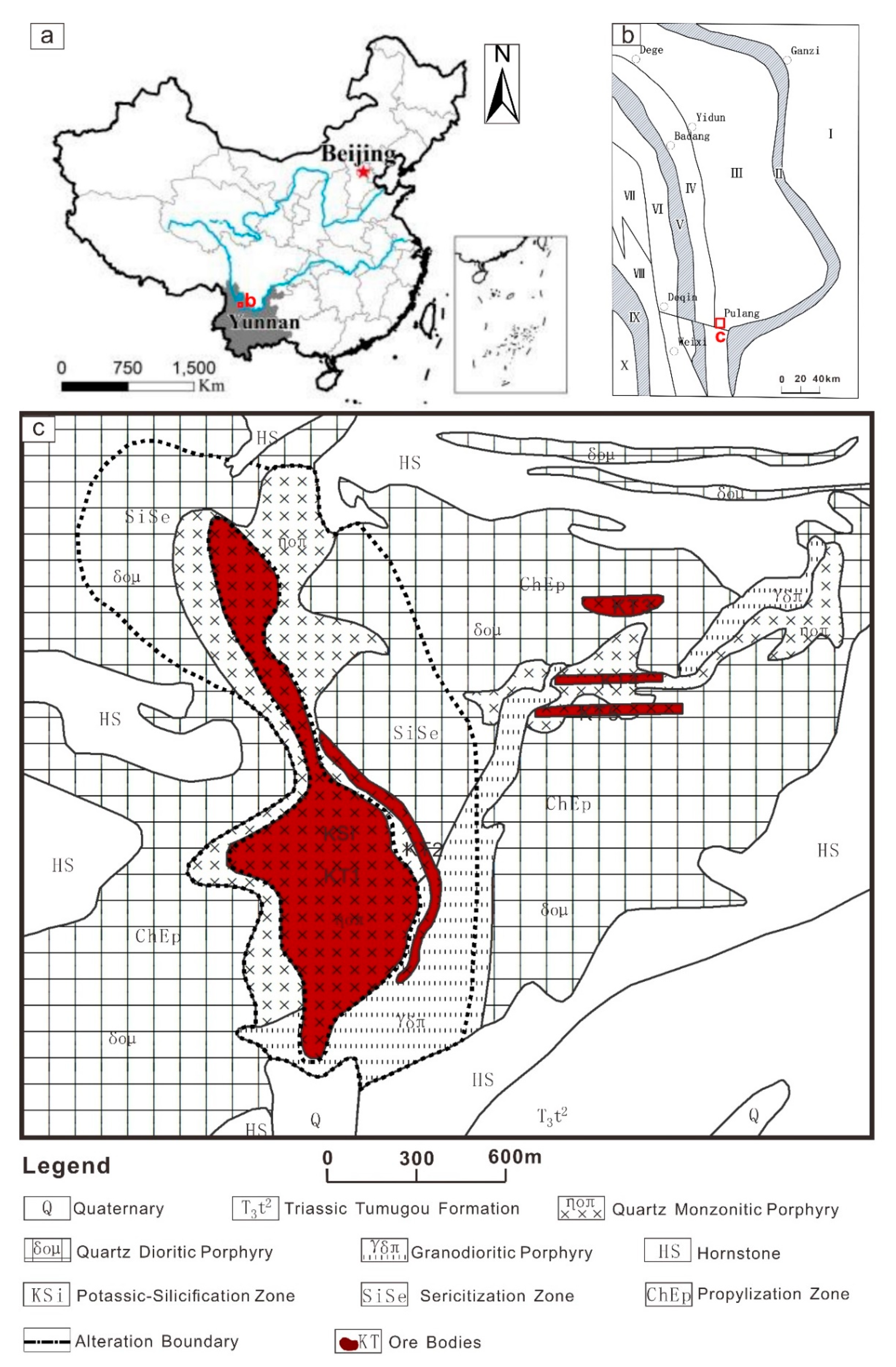
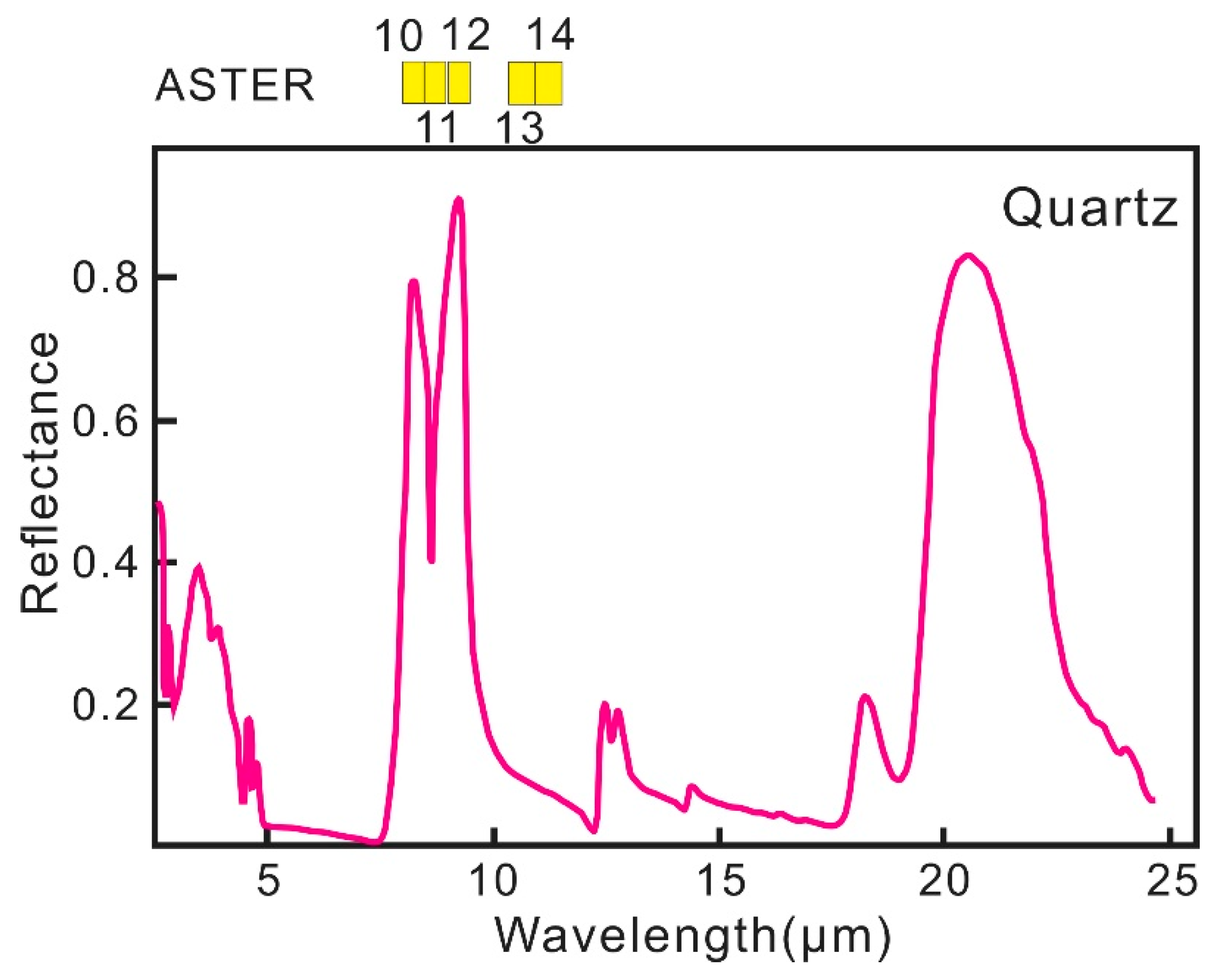
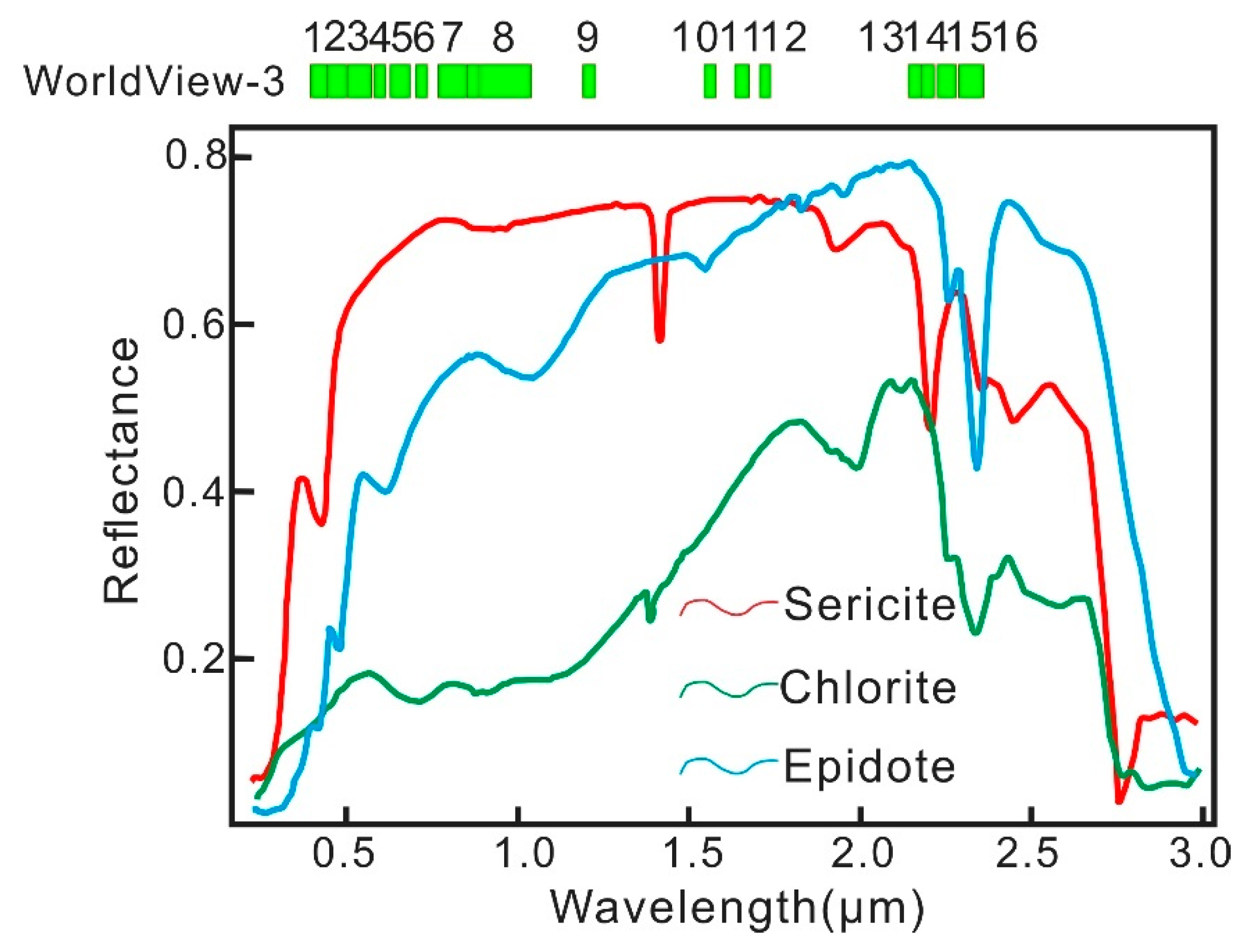

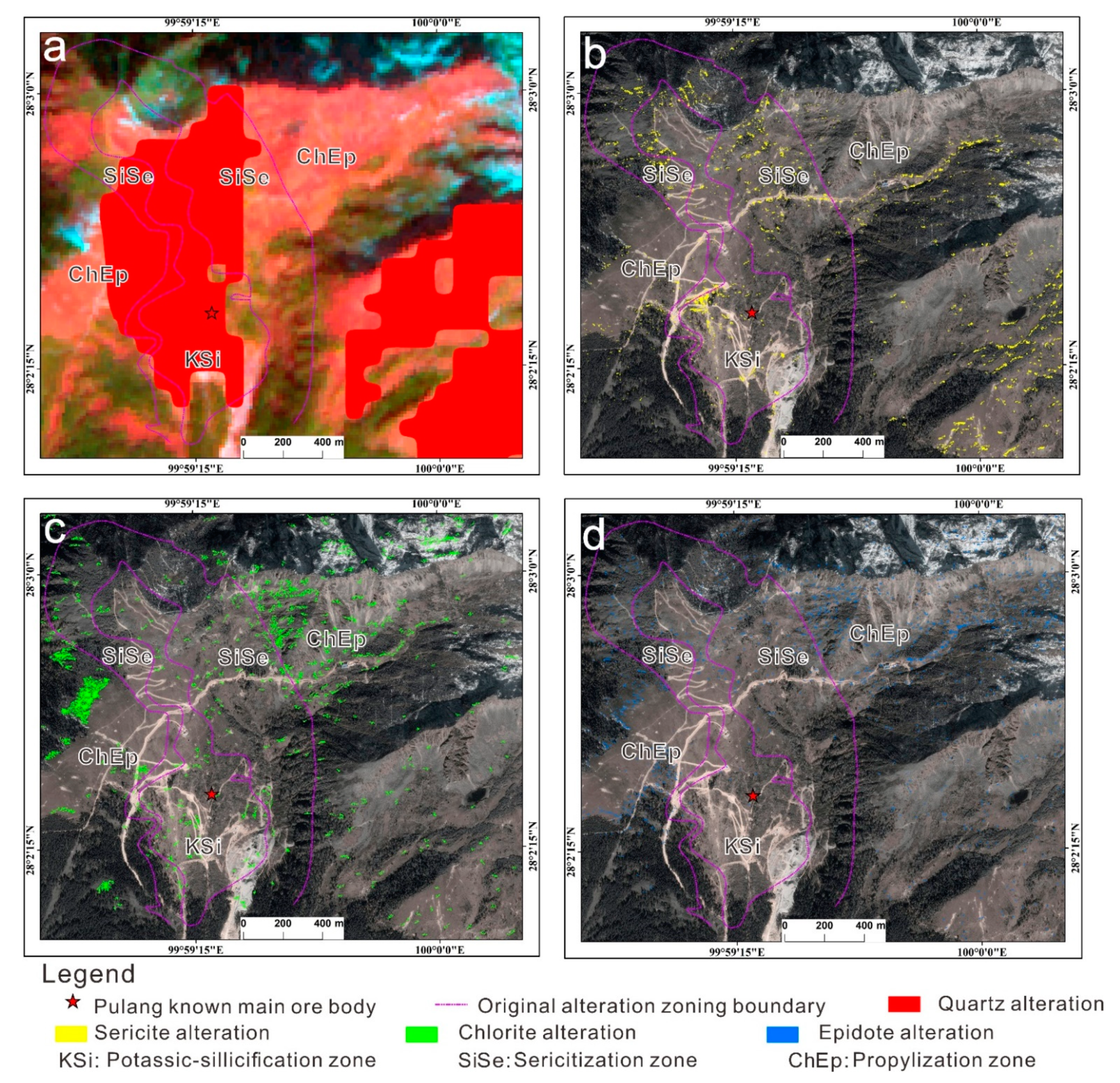
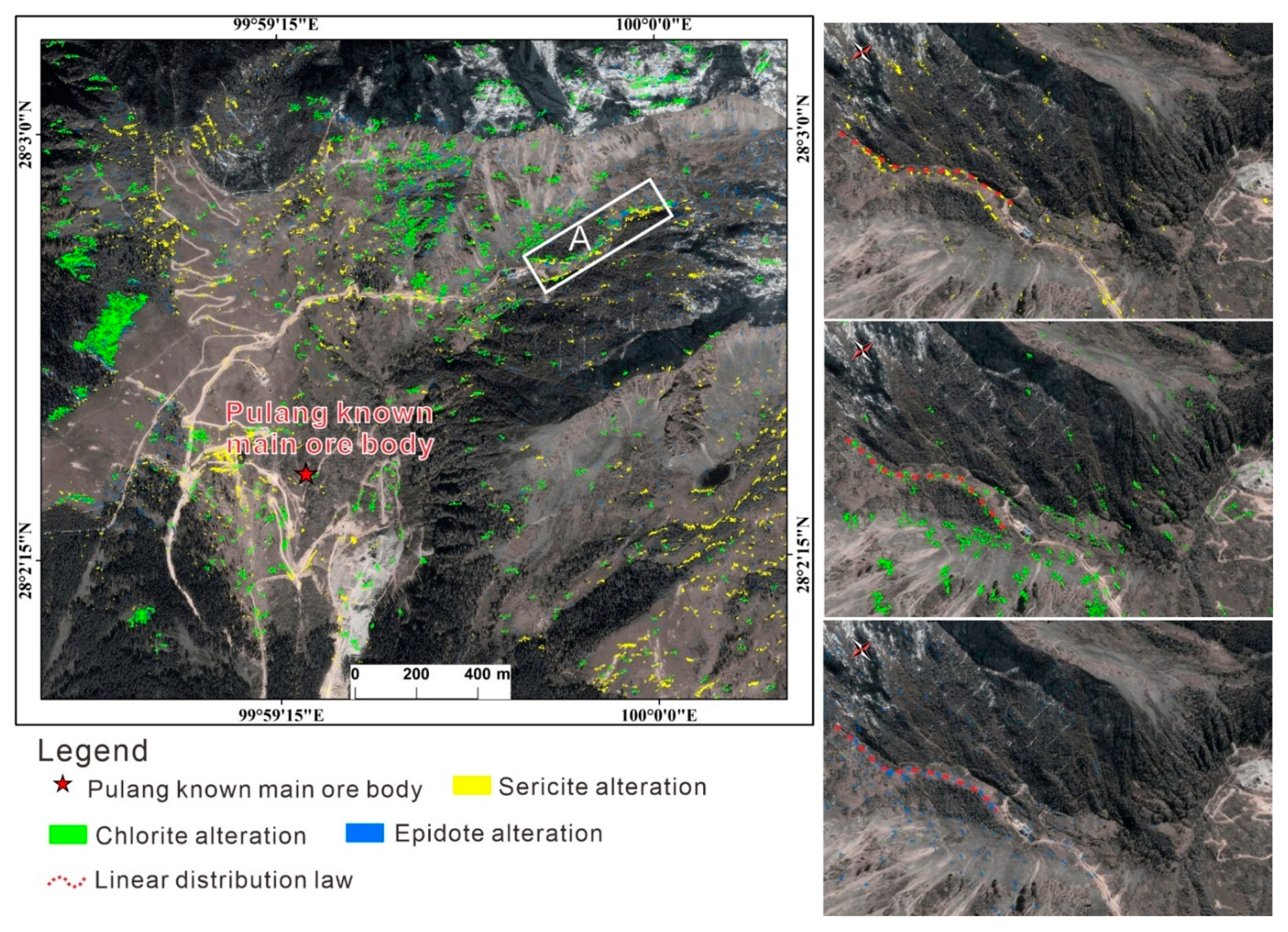
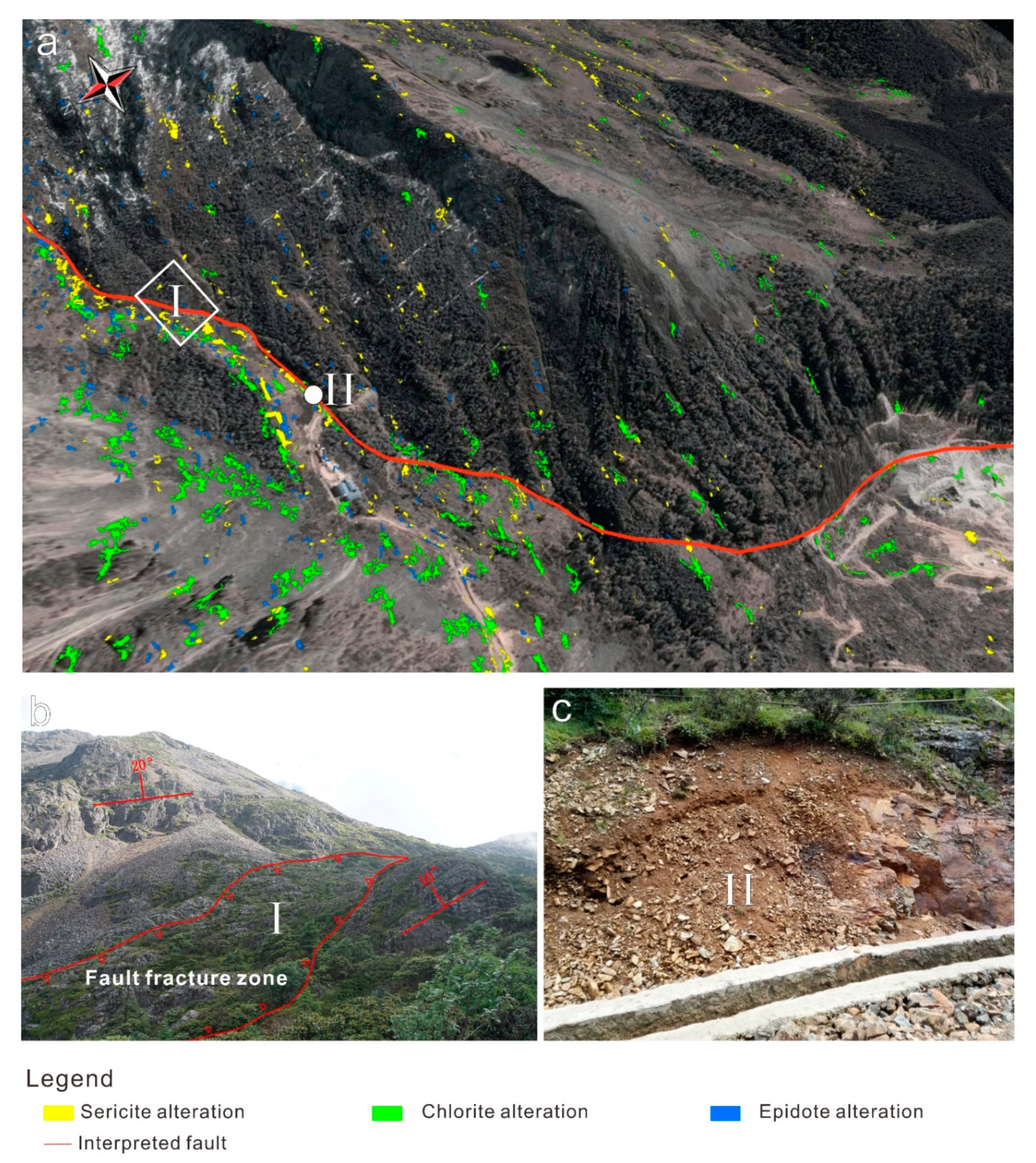
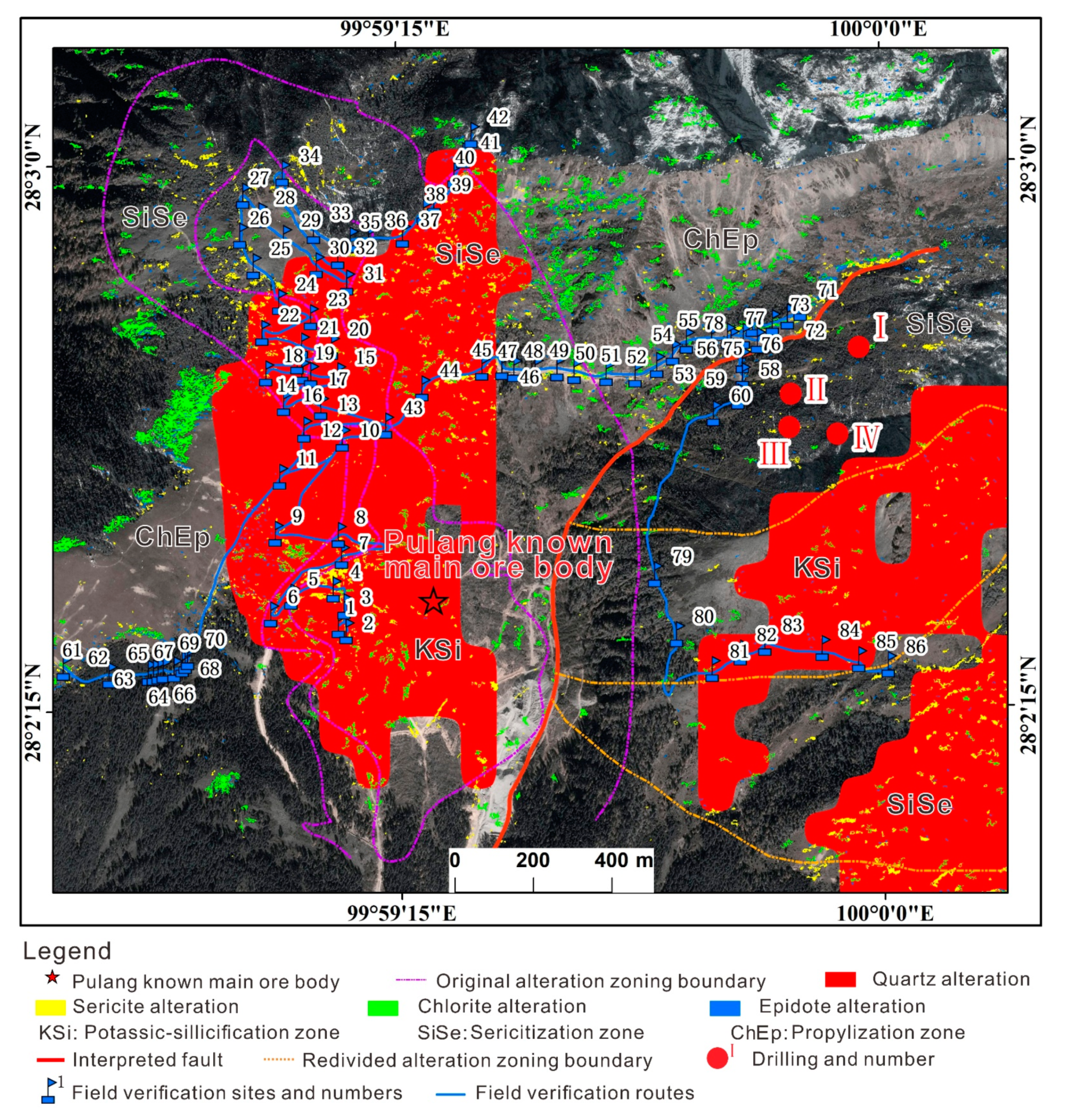
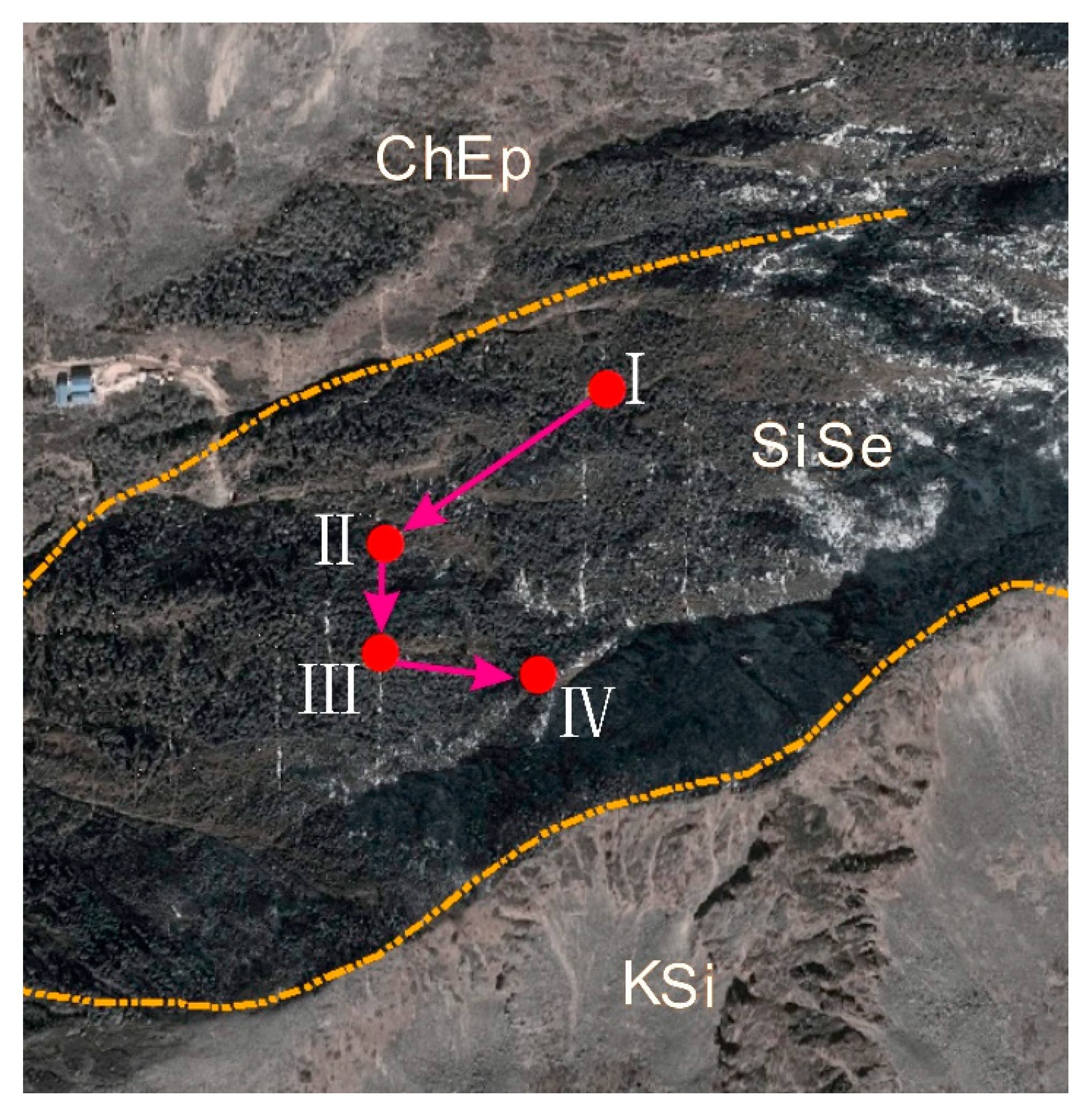
| Sensors | Subsystem | Band Number | Spectral Range (μm) | Spatial Resolution (m) | Swath Width (km) |
|---|---|---|---|---|---|
| ASTER | VNIR | 1 | 0.520–0.600 | 15 | 60 |
| 2 | 0.630–0.690 | ||||
| 3 | 0.760–0.860 | ||||
| SWIR | 4 | 1.600–1.700 | 30 | ||
| 5 | 2.145–2.185 | ||||
| 6 | 2.185–2.225 | ||||
| 7 | 2.235–2.285 | ||||
| 8 | 2.295–2.360 | ||||
| 9 | 2.360–2.430 | ||||
| TIR | 10 | 8.125–8.475 | 90 | ||
| 11 | 8.475–8.825 | ||||
| 12 | 8.925–9.275 | ||||
| 13 | 10.25–10.95 | ||||
| 14 | 10.95–11.65 | ||||
| WorldView-3 | VNIR | 1 | 0.400–0.450 | 1.24 | 13.2 |
| 2 | 0.450–0.510 | ||||
| 3 | 0.510–0.580 | ||||
| 4 | 0.585–0.625 | ||||
| 5 | 0.630–0.690 | ||||
| 6 | 0.705–0.745 | ||||
| 7 | 0.770–0.895 | ||||
| 8 | 0.860–1.040 | ||||
| SWIR | 9 | 1.195–1.225 | 3.70 | ||
| 10 | 1.550–1.590 | ||||
| 11 | 1.640–1.680 | ||||
| 12 | 1.710–1.750 | ||||
| 13 | 2.145–2.185 | ||||
| 14 | 2.185–2.225 | ||||
| 15 | 2.235–2.285 | ||||
| 16 | 2.295–2.365 |
| Eigenvector | QI | CI | MI |
|---|---|---|---|
| PC1 | 0.620732 | 0.586557 | 0.520233 |
| PC2 | 0.725769 | −0.178896 | −0.664270 |
| PC3 | 0.296565 | −0.789903 | 0.536752 |
| Band 1 | Band 6 | Band 14 | Band 15 | |
|---|---|---|---|---|
| PC1 | 0.076493 | 0.165927 | 0.716485 | 0.673250 |
| PC2 | −0.490367 | −0.845052 | 0.209057 | 0.041501 |
| PC3 | −0.451157 | 0.364897 | −0.538114 | 0.611344 |
| PC4 | 0.741719 | −0.353844 | −0.391634 | 0.413849 |
| Band 3 | Band 5 | Band 13 | Band 16 | |
|---|---|---|---|---|
| PC1 | 0.171027 | 0.127509 | 0.839833 | 0.499170 |
| PC2 | −0.816718 | −0.535923 | 0.172496 | 0.126504 |
| PC3 | 0.122032 | −0.148993 | −0.503014 | 0.842548 |
| PC4 | −0.537429 | 0.821176 | −0.109095 | 0.157921 |
| Band 4 | Band 7 | Band 13 | Band 16 | |
|---|---|---|---|---|
| PC1 | 0.047524 | 0.995742 | 0.065523 | 0.044114 |
| PC2 | −0.227916 | 0.085206 | −0.637216 | −0.731266 |
| PC3 | −0.971539 | 0.029576 | 0.118582 | 0.202918 |
| PC4 | 0.043679 | −0.019055 | −0.758684 | 0.649714 |
| Field Verification Point No. | Detected Alteration Mineral | Alteration Zoning Divided by the Original Alteration Mapping | Petrographic Analysis Photo | Analysis of the Redivide Alteration Zoning |
|---|---|---|---|---|
| 43 | Quartz | Potassic-silicification zone | 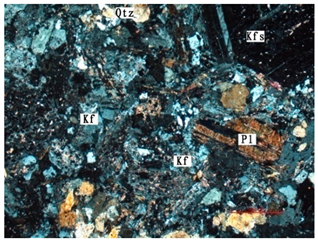 | Potassic-silicification zone, abundant quartz, and K-feldspar content. |
| 47 | Sericite | Phyllic zone | 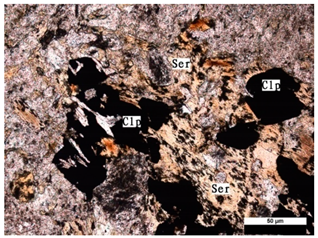 | Phyllic zone, abundant sericite, and chalcopyrite content. |
| 51 | Chlorite, Epidote | Propylitic zone | 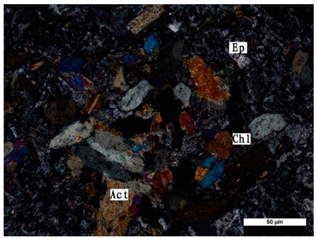 | Propylitization zone, abundant chlorite, epidote, and actinolite content. |
| 59 | Sericite | Propylitic zone |  | Phyllic zone, abundant sericite, and chalcopyrite content. |
| 82 | Quartz | Propylitic zone |  | Potassic-silicification zone, abundant quartz, and chalcopyrite content. |
| 83 | 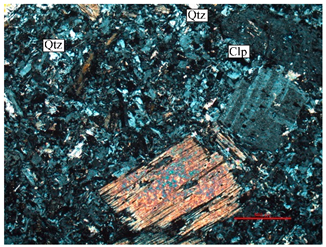 | |||
| 85 | 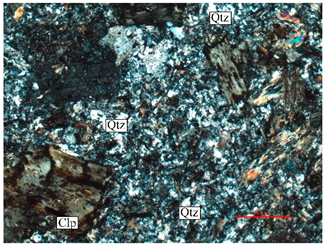 |
Publisher’s Note: MDPI stays neutral with regard to jurisdictional claims in published maps and institutional affiliations. |
© 2021 by the authors. Licensee MDPI, Basel, Switzerland. This article is an open access article distributed under the terms and conditions of the Creative Commons Attribution (CC BY) license (https://creativecommons.org/licenses/by/4.0/).
Share and Cite
Chen, Q.; Zhao, Z.; Zhou, J.; Zeng, M.; Xia, J.; Sun, T.; Zhao, X. New Insights into the Pulang Porphyry Copper Deposit in Southwest China: Indication of Alteration Minerals Detected Using ASTER and WorldView-3 Data. Remote Sens. 2021, 13, 2798. https://doi.org/10.3390/rs13142798
Chen Q, Zhao Z, Zhou J, Zeng M, Xia J, Sun T, Zhao X. New Insights into the Pulang Porphyry Copper Deposit in Southwest China: Indication of Alteration Minerals Detected Using ASTER and WorldView-3 Data. Remote Sensing. 2021; 13(14):2798. https://doi.org/10.3390/rs13142798
Chicago/Turabian StyleChen, Qi, Zhifang Zhao, Jiaxi Zhou, Min Zeng, Jisheng Xia, Tao Sun, and Xin Zhao. 2021. "New Insights into the Pulang Porphyry Copper Deposit in Southwest China: Indication of Alteration Minerals Detected Using ASTER and WorldView-3 Data" Remote Sensing 13, no. 14: 2798. https://doi.org/10.3390/rs13142798
APA StyleChen, Q., Zhao, Z., Zhou, J., Zeng, M., Xia, J., Sun, T., & Zhao, X. (2021). New Insights into the Pulang Porphyry Copper Deposit in Southwest China: Indication of Alteration Minerals Detected Using ASTER and WorldView-3 Data. Remote Sensing, 13(14), 2798. https://doi.org/10.3390/rs13142798






